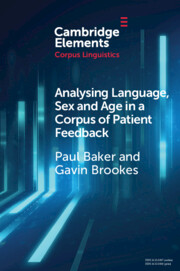Analysing Language, Sex and Age in a Corpus of Patient Feedback
A Comparison of Approaches
Published online by Cambridge University Press:
27 June 2022
- Paul Baker
- Affiliation:
Lancaster University
- Gavin Brookes
- Affiliation:
Lancaster University
Summary
This Element explores approaches to locating and examining social identity in corpora with and without the aid of demographic metadata. This is a key concern in corpus-aided studies of language and identity, and this Element sets out to explore the main challenges and affordances associated with either approach and to discern what either approach can (and cannot) show. It describes two case studies which each compare two approaches to social identity variables – sex and age – in a corpus of 14-million words of patient comments about NHS cancer services in England. The first approach utilises demographic tags to group comments according to patients' sex/age while the second involves categorising cases where patients disclose their sex/age in their comments. This Element compares the findings from either approach, with the approaches themselves being critically discussed in terms of their implications for corpus-aided studies of language and identity.

